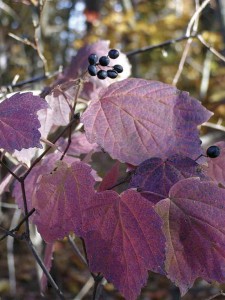A late-fall color worth the walk
Originally published November 25, 2008

Photo by Ken Moore. Dusty-pink leaves of maple-leaved viburnum with drupes.
By Ken Moore
Lots of trees are bare, cold temperatures reign, and yet our Piedmont flora continues to glow. The scarlet-red fern-like leaves of sumacs are still dramatic along roadsides and the rich burgundy-reds of highbush blueberries are noticeable against otherwise leafless forest edges.
If you venture into the forests, you will encounter the subtler colors of native viburnums, often called arrowwood because Native Americans used the hard straight stems of these shrubs for arrow shafts.
On a walk this past Sunday, I delighted in seeing leaves of maple-leaved viburnum, Viburnum acerifolium, taking on dusty-pink colors. A few of the plants still bore small clusters of black drupes, a surprise because the birds usually grab those preferred tasty morsels immediately. I’ll wager that following the recent freezes, those fruit will be absent, though the leaves will linger. Some of the foliage was still green, just beginning to turn. You may remember having seen the viburnums’ flat-top clusters of white flowers scattered throughout the local forests during the middle of spring. It’s fun to visualize the spring appearance of plants when seeing them in their fall habit.
The maple-leaved viburnum is easy to spot; the Latin of its name, V. acerifolium, translates as “maple†(acer) “leaf†(folium). So you are looking for a waist-to-head-high shrub with opposite leaves, like maple trees, and a leaf shaped, in this case, like that of the red maple.
Keep a keen eye out for this pale pink-leaved beauty because, though common, it is scattered here and there throughout the forest. Sometimes you will discover a nice thicket of it on some of the forest slopes.
Far more common, making extensive thickets on low ground as well as upper slopes, is the closely related downy-leaved viburnum, V. rafinesquianum, also called arrowwood. This viburnum was named in honor of Constantine Samuel Rafinesque (1783-1840), who is underappreciated as an early American botanist and natural historian; if you take a little time to research his adventurous life, you’ll find amazing anecdotes to share at your next dinner party.
Leaves of downy-leaved viburnum are opposite (like all viburnums), short-petioled, coarsely toothed (serrate) and egg-shaped (ovate), easy to distinguish from those of its longer-petioled, maple-leaved cousin. Its leaves are a nice coppery pink, not dusty pink. Both are quite drought resistant and make fine garden plants.
As noted many times in previous articles, we are fortunate in our Piedmont region to have the brilliant and subtle leaf color begin in late summer and slowly progress into winter. Take a walk on Thanksgiving Day and make note of how many trees and shrubs are still holding colored foliage. And don’t forget to direct your viewing occasionally to the ground of the forests, forest edges and fields. You’ll be surprised to spot amazing colors on stems of not-quite-dormant perennials and the winter basal rosettes of other perennials and winter annuals that remain quietly active right on through the cold months. You’ll discover a lot just by walking slowly and taking those closer looks. So bundle up and take yourself outdoors! There’s lots to discover!


Comments are closed.